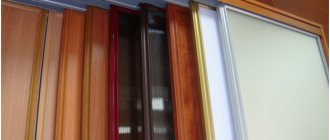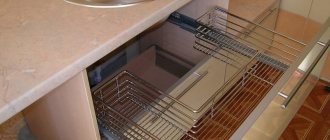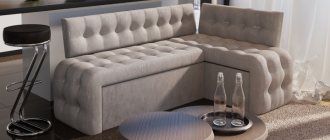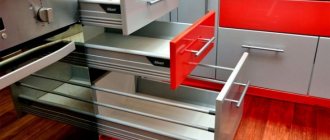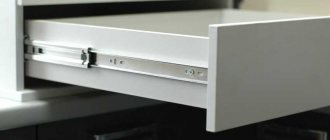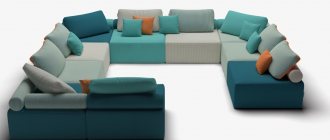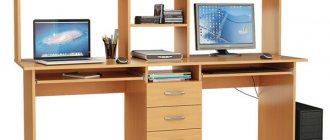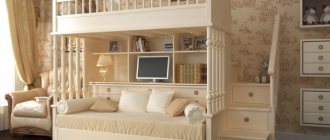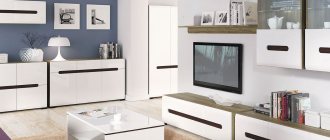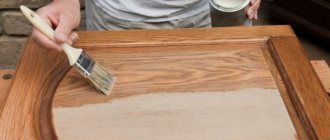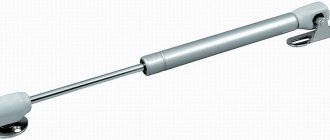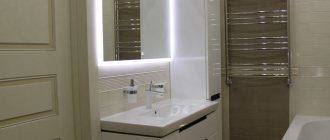Today, designers are given complete freedom of action. Furniture manufacturers have stepped far forward, so now we enjoy a variety of models and choose our favorite furniture components. But design cannot be complete without furniture fittings, which affect the technical characteristics and functionality of products.
What does it represent? Main types
So, by front fittings we mean all the parts installed specifically from the front part. First of all, we will include pens. They not only perform their main function, allowing you to quickly open the doors with great convenience, but also influence the appearance of the headset and can transform it and become the central part.
This group also includes external locks and latches. The main thing is that they are reliable, but do not stand out too much.
Let's talk separately about purely decorative elements; however, they sometimes hide scratches on the coating, conspicuous joints or the heads of some fasteners.
Types of furniture overlays
It’s hard to name overlay decor and accessories. Rather, it is an addition to the usual interior items. It is produced in the form of three-dimensional and flat figures from different materials. Wooden products are common, but you can also find presentable and neat plastic or metal ones. Functional purpose - masking all kinds of defects, decoration.
The following accessories are often used:
- Corner – for smoothing rough corners;
- Patterned strips - moldings;
- Heraldic symbols;
- Decorations in the shape of an animal's head are mascarons.
If the furniture is made of laminated chipboards (LDSP), there is a need to cover the edges; they stand out too much and negatively affect the appearance. They are hidden using decorative tapes - melamine, moisture-resistant PVC, acrylic or veneer. As a rule, they are glued by the manufacturer, but during operation, for example, of a cabinet, their integrity may be compromised, so they are also useful for ordinary retail buyers and will help in restoration.
This is interesting: The scope of use of overhead furniture hinges, their features
Types of furniture fittings
All fittings can be divided into two large groups or classes:
- Facial fittings perform a more decorative function, although they can also carry some functional load. This class of products includes fittings located on the front side of the furniture:
edge – designed for processing the ends of furniture elements and their additional protection from mechanical stress; handles and locks – elements of furniture decor designed for convenient opening/closing and locking of drawers, doors and doors; various decorative overlays, used both for decoration and for masking joints.
- Fastening fittings are designed to connect individual furniture elements into a single whole.
There is another group of fittings that stands apart. These are mechanisms that change the operational characteristics of furniture:
- accessories for sliding tables;
- various “guiding” elements;
- mechanisms that help transform folding sofas and armchairs.
Which fastening hardware to choose for certain types of material
Modern manufacturers make furniture not only from chipboard, but also from other materials.
Thanks to the wide range of fittings, you can choose fasteners for any type of furniture
Table 6. Selection of fasteners based on the furniture material.
| Material | Description |
Glass | Fasteners such as self-tapping screws (of the “quick installation” type) are used, which are screwed into the wall. Usually this is a thin self-tapping screw with a plastic attachment. Also, fasteners can have a special adhesive composition and a rubber gasket. They provide fixation of shelves and glass surfaces, while the furniture coating is not damaged. Glass doors on a cabinet can be installed using regular furniture hinges. |
Metal | Screw fasteners are ideal for connecting metal parts. They can be fixed to the stand using a screwdriver/drill. To prevent the furniture from losing its aesthetic appearance, the head of the fasteners can be closed with a plug. |
| Plastic and chipboard | To fix such furniture, you can use any fasteners that are designed for chipboard. |
Telescopic guides for drawers are modern fittings that allow you to effortlessly open even massive structures. Would you like to learn in detail about the installation of telescopic guides and the correct calculation for their installation? Read the special article.
Secrets of designer selection of furniture fittings
Check out design tips that will help you make the right choice of furniture fittings.
- Since metal fittings are the most common in furniture design, you can choose imitation bronze, gold, brass, and silver. Popular options are chrome and gold.
- It is necessary to take into account the temperamental characteristics of the person who will use this fittings. For example, for an active and energetic person it is better to use spring hinges and various closers, while a balanced and calm person, on the contrary, can use more economical fittings.
- The frequency of use of furniture should also be taken into account. The furniture that you will use many times a day should have reliable and durable fittings. Furniture that you rarely use does not need to be equipped with expensive mechanisms.
Handles as remarkable façade details
It is impossible to imagine furniture with opening fronts without handles; these are mandatory attributes that immediately catch the eye. They must be comfortable, ergonomic, elegantly designed, and perfectly combined with the base. They differ not only in design.
Popular models
Let's take a look at the form. Perhaps the most popular and simple ones are in the form of a staple. Let's highlight their advantages:
- Ease of installation;
- Wear resistance;
- A wide range of products, the ability to choose the right size, color and material of manufacture.
Let’s also add that buying a furniture handle-bracket cheaply is as easy as shelling pears. Really affordable and, importantly, durable.
Other popular options are drops. L-shaped, with the handle noticeably widening towards the end to make it more comfortable to hold on to.
Knobs and buttons are also often found. Round, streamlined or with sharp corners, square, very convenient, available in stationary and rotary types (combined with a lock).
Metal ring handles made in a classic style look interesting. They convey notes of antiquity and aristocracy. Gothic models are fascinating.
If protruding features aren't to your liking, take a look at pull-behind sinks or built-in modifications.
What to look for when choosing
Before buying furniture handles, decide on their shape. In addition, the material that is used is of great importance. Economy option - plastic. Easy to care for, not afraid of moisture, available in different colors.
Metal with a decorative coating has proven itself well. Aluminum, brass and steel accessories are relevant.
You can also find ceramic accessories. Elegant, attractive, but vulnerable to mechanical stress.
Remember reliability, practicality, and comfort of daily use.
Types and purpose of kitchen fittings
Kitchen furniture fittings are divided into external and internal. The first is represented by numerous handles and less commonly used legs (another name is supports). The most serious demands are always placed on handles in the kitchen. They are explained extremely simply - this piece of furniture should not only be extremely functional, but also attractive, since it is an important decorative element of the interior of the room. A consequence of this state of affairs is the relevance of the question of which kitchen handles are better. The answer to it is posted in a special section of the article. Internal fittings are represented by several products:
Dampers
They are used as shock-absorbing devices that reduce mechanical shock impacts on furniture when opening and closing doors.
Guides
There are two types - roller and ball. They are mechanisms in the form of original rails for pulling out kitchen drawers and other furniture.
Hinges (hinges)
One of the most common types of fittings, which is designed to allow doors to open and close.
Lifting mechanisms
A separate type of fittings responsible for raising and lowering furniture facades.
Requirements for fittings for cabinet and upholstered furniture
Let's start with the main thing - how to determine the quality of fittings “by eye” when you choose furniture. This knowledge will help you distinguish the original from fakes and Chinese manufacturers.
Famous manufacturers label their products. All products from Boward, Blum, Hettich and other popular brands have it. Lesser-known brands do not have manufacturers. If you are looking at hinges, gas lifts and other elements, pay attention to the markings - and everything will immediately become clear.
Let’s make a reservation that European-made fittings are always priced above the average price segment on furniture. It even happens that high-quality accessories take up more than 40% of the cost of production. That’s why less famous hardware manufacturers are used in overly cheap products. By the way, they are not always worse, they are just not as famous.
How to immediately identify low quality?
On those elements that are going to break as quickly as possible, you will find the following defects:
- Incomplete closure of facades;
- Creaking when opening and closing facades;
- Uneven color;
- Galvanic coating defects;
- Tight, complicated movement of guides and gas lifts.
Metal fasteners
We often hear this name, but not everyone knows what it means. Hardware is metal fasteners. Their function is to ensure reliable connection of furniture elements to give it the necessary rigidity.
Furniture hardware includes:
- Euroscrew (confirmant) is a furniture fastening element that ensures reliable fixation of a furniture unit. The advantages of this fastener are that at any time this furniture can be disassembled without much effort and reassembled in a short time.
- Intersectional tie – this type of fastener connects ready-made sections of assembled furniture. When connected with this type of screed, the structure gains high strength.
- Eccentric screed - the main difference from all other types of furniture fasteners is that this screed is completely invisible from the front of the product. However, you need to take into account that installing this screed takes much longer than its analogues.
This is interesting: Types of furniture fasteners, their characteristics and application features
Types of fastening accessories
Fastening or connecting fittings are represented by many elements, which can be divided into several large groups:
- Movable joint fittings are various types of hinges, differing both in the method of fastening and in the opening angle, devices for mounting sliding doors, lifting mechanisms (microlifts): both mechanical and gas.
- Fittings for permanent connections are elements designed for reliable fixation of individual furniture parts relative to each other: intersectional and eccentric ties, confirmatories, rods and self-tapping screws.
- Fittings for detachable connections are represented by various types of latches, latches, and locking hooks. This group also includes elements such as magnetic latches and shelf holders.
When choosing furniture fittings, one should not forget that its quality and reliability in operation directly affects the life of the furniture. The importance of choosing fittings is also emphasized by the numbers - its share in the cost of furniture can range from 10 to 25 percent of the total amount.
Wardrobe systems
Sliding wardrobes are in demand in apartments due to their convenience. Sliding door systems allow you to save space in rooms. They differ in the type of installation. The most popular are:
- Roller profiles are a system of upper and lower profiles that are fastened with self-tapping screws inside the furniture frame. Using rollers, the door leaves move along the profiles to the right/left. The main load in this design falls on the lower profile.
- Hanging - consist of an upper profile to which the door is attached.
Often such mechanisms are equipped with special door locks. By installing furniture fittings with stoppers, the sound of the door hitting the side wall is muffled. Systems for cabinets consist of guides, handles, rollers, strips, seals, and stoppers. In such an innovative sliding door mechanism as coplanar, an additional element of the fittings is the door leaf leveler. It allows the door to move forward when opened, and to return to its place when closed. As a result, the facade of a closed cabinet visually looks like one plane.
Hanging
Roller
Installation of fittings
High-quality fittings are designed for long-term use. But if the furniture breaks down, then it needs to be repaired or the necessary element needs to be replaced. Sometimes it happens that the simplest mechanism is difficult to repair and it is better to replace it with a new one. The instructions for the fittings will help with this. For example, you can quickly and easily change a handle or a hinge.
And it will be difficult for an inexperienced person to replace the retractable mechanism. In this case, it is better to contact an experienced furniture maker. Installing fittings on furniture requires knowledge and experience. Therefore, entrust complex replacements to a specialist.
Main types of furniture fittings
When choosing furniture, it is important to pay attention not only to its appearance, because parameters such as durability and functionality will be more important. The fittings that are equipped with each product are responsible for these characteristics. There is a wide variety of details that simplify use and increase the service life of furniture.
For normal functioning, furniture is equipped with a variety of fittings
Door handles
There are three main types of pens, these are:
- stationary;
- with a push mechanism;
- rotary.
Stationary models are found exclusively on cabinet doors and bedside tables. They are not equipped with a lock; they allow you to pull or push the door and often have a decorative function. The remaining types are distinguished by the presence of a latch or lock, so they are much more common.
It is impossible to imagine a single door without handles
Wheels
Today on the furniture market you can find a lot of models of furniture on wheels. They are necessary for the free movement of the product around the house. Each type of wheel is different:
- adjustment parameters;
- fastening;
- rotation method.
When choosing such accessories, it is important to pay attention not only to quality and attractive appearance. It is necessary that the wheels match the style of the furniture (on which they will be attached) and the room as a whole.
Wheels for furniture come in different sizes
All types of wheels can be divided into two main subtypes.
- Swivel - allow you to move furniture around the house without much effort.
- Fixed - able to withstand heavy loads, but do not have good maneuverability, so furniture is much more difficult to move.
Legs
Almost all types of furniture must be equipped with legs/supports. Since they support the entire structure, the legs must be of high quality, but we must not forget about their design. This type of fittings can be divided into 3 groups.
- Regular, without height adjustment. They often represent an inexpensive support for furniture. They feature a laconic design.
- Models with the ability to adjust height. These legs are ideal for rooms with uneven floors, allowing you to level the furniture.
- Decorative - used as decoration. Models can be varied, for example, with threads, non-standard shapes.
Legs are usually present on the base of the cabinet, as well as chairs, tables
Metal models are usually made from:
- chromium;
- aluminum
They are durable and strong. Such legs harmoniously combine with various interior items.
Wood is often used to create decorative models. It is better to choose legs made of expensive wood, since they differ:
- attractive appearance;
- high quality.
Plastic models do not differ in aesthetic appearance, however, they compensate for this:
- wide range of sizes;
- functionality.
An example of what adjustable legs look like
Loops
Furniture hinges refer to connecting fittings that allow doors to be opened/closed. There are different types of hinges, they depend on the configuration of the cabinets and their facades. Such fittings can be equipped with closers for silent and smooth operation.
Hinges are a mandatory part on the cabinet that ensures the functioning of its door.
Table 7. Main types of loops.
| View | Description |
| Invoices | The most common hinges that allow doors to open 110 degrees. Used on swinging facades. |
| Semi-overhead | Such canopies are used to equip cabinets, the doors of which are fixed on one side and swing open in different directions. They allow the door to open 110 degrees. |
| Domestic | Such hinges are used to equip facades that are located between two side parts. They provide door opening 100 degrees. |
| Corner | Ideal for a corner drawer. The door can only be opened 90 degrees. |
| Adit | They are attached to overhead strips located at the same level as the furniture facade. The doors can only be opened 90 degrees. |
| Complex | Used for corner boxes with L-shaped frames. The hinges are attached in the middle of the two facades, ensuring their synchronous opening. |
| Transformer | They are used in conjunction with complex canopies. The hinge is capable of holding two facades on itself at the same time and allows you to open the doors at a large angle. These hinges are also appropriate if the cabinet is equipped with a drawer. |
Furniture hinges with a closer are expensive fittings with a complex design. Thanks to the shock absorber built into the hinges, the doors will close independently. Would you like to get acquainted with the varieties of this fittings in detail? Then read our specially prepared article.
Locks
The purpose of this fitting is to allow the door to be fixed in one position. There are three types of locks:
- latch;
- lock with key;
- lock for the bathroom.
The latches have simple functionality - to operate them you just need to slam the door. Often, doors with a push handle are equipped with such a mechanism.
Locks look appropriate on furniture made of any material
Key locks allow doors to be locked to prevent unauthorized access. Models for the bathroom are a mechanism with a turntable that can be closed from the inside. This option is more appropriate for ordinary doors than for furniture.
Mortise locks will also be relevant for furniture. They have a high reliability index, and most importantly, do not spoil the appearance of the furniture. There are such locks:
- cruciform;
- cylinder;
- suvaldnymi.
Lever locks work on the principle of moving metal plates into grooves
The simplest is considered to be a furniture lock. They can be mounted on furniture made of chipboard and glass. They are even suitable for double doors.
Hooks
This type of fittings must withstand heavy loads, so when choosing hooks it is important to pay attention to the quality of the metal from which they are made. The hooks are different:
- shape;
- style;
- sizes;
- functionality;
- design.
Among the most popular hooks are one, two and three-arm models. They can be attached independently to any furniture. The purpose of this accessory is to store various things, mainly clothes.
An example of what the main types of furniture hooks look like
Prices for various furniture accessories
Furniture fittings
Basic varieties
All mechanisms and accessories are divided into several varieties. Each of them performs its own function and, accordingly, must meet certain requirements.
Facial
These elements not only carry a functional load, but also remain visible, so the appearance of the furniture largely depends on the front fittings. This type includes the following auxiliary accessories:
- Legs - the stability of the structure and safety of operation depend on them. The supporting furniture element must support the weight of the product and protect the place of contact with the floor covering from it, so as not to scratch or push through the latter. Among the modifications of this fittings are adjustable legs, which allow you to install furniture at the desired height or level it on an uneven floor.
- Wheels or roller supports allow you to easily move furniture. Such fittings are usually used for models that are often moved from place to place (coffee tables, computer chairs), as well as for sliding sofas. This type of headset can be linear or rotary, bushing or bearing. As an additional element, manufacturers provide such products with a stopper.
- Edge - lining the surfaces of the ends of furniture. Edges are distinguished by surface type (with structure, glossy, smooth, others), as well as by the method of fastening (overhead, mortise, rigid).
Wheels
Legs
Edge
Industrial furniture is already equipped with front elements, which makes it possible not to think about purchasing additional materials. When choosing furniture fittings on your own, first of all, preference should be given to reliability and quality. But the styling of the components also plays an important role.
The group of front fittings for detachable furniture includes:
- Handles that open doors, drawers or furniture doors. There are many varieties of this fittings: in the form of a bracket, a button, a ring, a drop. These can also be profiles, roof rails, sinks. Handles are divided into overhead and mortise.
- Locks designed to provide more secure storage of securities and things. They can be mortise, which do not spoil the appearance of the furniture (they are considered more reliable), as well as overhead, attached to the top of doors or drawers. Based on the closing mechanism, push-button, retractable, rotary, and rack-and-pinion varieties can be distinguished.
- Snap hooks are the easiest way to secure a door in a closed position. The loop of the furniture fittings of the hook is fixed on the movable part of the furniture, while the element itself is fixed on the fixed facade.
- Latches, or magnets, are designed to hold doors tightly closed and prevent them from opening spontaneously. They are used as additional or independent door fastening mechanisms. Latches are divided into built-in locks with a magnetic key, models with a bolt that fits into a groove when closed, and magnetic varieties with a locking mechanism.
- Espagnols are also used to secure doors, windows, and gates. According to the principle of operation, they are divided into mechanical (opened and closed manually), as well as automatic, in which when the door slams, the bolt extends, and to open it you subsequently need to press a button.
Types and characteristics of furniture hinges, fastening rules
You can add decorative elements to a separate type of front fittings. They complement the interior with originality and give the entire room a single style coloring, for example, antique. Used to mask joints or design features of furniture. The variety of decorative elements is great. As an example, we can cite an agraph that connects the tops of arches, openings, and niches. As a standard, the element is decorated with carved leaves, branches, and connected at one point in the middle of the top of the arch.
Lock
Magnet
Cap hook
Pens
Espagnolette
Fastening and tightening
The main elements of fastening and fastening fittings for furniture:
- hangers and rails for cabinets - metal plates attached to the wall using self-tapping screws;
- hardware - bolts, screws, screws, nuts, nails, dowels, self-tapping screws;
- body ties - specialized furniture fittings - eccentric or intersectional ties, connecting corners.
The function of fastening and tightening metal fittings for furniture is to facilitate assembly. Ultimately, it becomes invisible on the surface of the products.
Hardware
Screed
Tire
Connective
The function of such fittings is to connect and fix parts with each other. This type of product includes one-piece elements:
- Hinges - designed for closing drawers, cabinets or doors; in turn, they are divided into overhead and semi-overlay, internal and corner, inverse, piano and others.
- Canopy - also allows you to open or close doors; it can be four-hinged, piano, card, mezzanine, secretarial, card.
- Drawer slides provide ease of use with quiet, smooth operation. They are divided into the following types: roller, full extension, reverse action, hidden installation, metaboxes, tandemboxes.
- Mechanisms for flaps - allow the door to smoothly rise up to the fixation point, are divided into mechanical spring fittings and gas lifts.
- Models with closers - used to smoothly open or close cabinet doors; there are gas and oil types of these parts.
Connecting fittings are used in cabinets with doors and drawers.
Canopy
Guides
Loops
Closer
Sliding systems
Sliding systems are used in conventional and built-in wardrobes. This is a special door opening mechanism that ensures softness and quiet use of the headset. Varieties of such systems for furniture assembly: roller, consisting of hidden upper and lower profiles along which the door leaf moves on rollers, and hanging, where the door is suspended from the end of the cabinet.
Hanging
Roller
Shelf holders and fittings for mirrors
A separate type of furniture fittings are shelf holders designed for fixing shelves in cabinets, kitchens or dressing rooms. They are divided into open models, they are mounted to furniture (the shelf is placed directly on them), hidden, resembling an eccentric coupler. Glass fittings such as screws and plugs are used to attach mirrors. They involve drilling holes in the surface, so special rubber seals are additionally required.
Shelf supports
Accessories for mirrors
Cable channels and plugs
A cable channel is a box made of a profile that protects wires from external influences. Plugs mask mounting holes, bolts, nuts, and also prevent the accumulation of dust and dirt in legs and racks made from hollow pipes, and clothes hangers. The elements are supporting, protecting the floor covering from mechanical damage, and also hiding holes. This decorative fittings give the interior and furniture an aesthetic appearance.
Stubs
Cable channel
Hooks and hangers
Hooks, as an independent element of fittings, and components of hangers are designed for storing clothes in a hanging position. This type varies in size and design. Hooks can be mounted on the wall as a separate element or used in cabinet furniture. The most common are one, two and three-arm models.
Advantages of birch furniture panels, scope of application
Dampers
This type of furniture fittings is used in doors that rise up or open horizontally. The main function is to provide softness when closing. Dampers act as a shock absorber, allowing the door to slam silently. Depending on the operating mechanism, they are divided into hydraulic and pneumatic. Based on the method of fastening to furniture, we can distinguish such varieties as overhead, mortise, self-adhesive, and hinged.
Mechanisms of transformation
This type of fittings is used in the manufacture of convertible folding sofas. Such designs make it easy to change the position of the soft surface, increase the area of the sleeping area, and make the product more functional. Transformable furniture may involve the use of retractable, unfolding systems. In addition to sofas, fittings of this type are also used for folding tables.
Facade dimensions
The construction industry has introduced a wide range of façades with different dimensions to the market. The size of the frame facade depends on the profile, and the dimensions of products made from MDF boards depend on the capabilities of industrial equipment. For example, the minimum height of solid facades has a size of ─ 137-140 mm, a minimum width of ─ 296 mm, and a maximum height of ─ 988-1250 mm and a maximum width of ─ 596-1200 mm. And in frame-panelled facades, the minimum height is 562-573 mm, the minimum width is 296 mm, the maximum width is 596-896 mm and the maximum height is 980-1010 mm. When choosing a facade product, you need to pay attention to the beautiful design, the ability to fit into the interior of the room and the performance characteristics of the materials.
Preserving the durability of components
Caring for various furniture elements is the key to long-lasting service. Even high-quality components cannot last long if you do not follow certain rules for caring for them.
- Maintain cleanliness and appearance.
- Keep dust, water and other foreign substances away.
- Protect them from all kinds of physical activity. When cleaning parts, do not use cleaning liquids or other powders. They can damage the coating by entering into a chemical reaction with it.
- Frost and extreme heat can deform even high-quality components, so control the room temperature.
By following simple recommendations, you can choose high-quality products and extend the life of furniture components.
Article prepared by:
Ivan Gainulin
Online store manager.
More than 5 years of experience. Knows everything about furniture.
Furniture fittings and components
Furniture fittings and components are a direct part of the finished product along with other materials.
Regardless of the type of furniture or its category, there is a simple distribution of materials:
- the basis.
For cabinet furniture, this can be natural wood, particle boards or MDF. If we are talking about upholstered furniture, then this list includes upholstery fabrics and functional fillers (foam rubber, batting, felt); - accessories.
Furniture handles and legs decorate various cabinets, chests of drawers, pencil cases, making them attractive and stylish. If we are talking about functionality, then these are various mechanisms for opening facades (hinges, gas lifts, pneumatic closers). In the manufacture of upholstered furniture, accessories include mainly support or decorative legs, as well as various mechanisms for transforming sofas; - components.
This is a wide range of various auxiliary products, ranging from ordinary wallpaper nails to fasteners with decorative elements.
In addition to its practical purpose, furniture fittings also perform a decorative function, especially when it comes to external elements (handles for facades, support legs, rails and moldings).
Facades
In a furniture design, all visible parts that face the front or side plane are called facades. Their configuration and color determine the style of the furniture and set the tone for the entire room.
Main types of facades:
- Doors;
- Front walls of drawers;
- Horizontal and vertical decorative overlays;
- Furniture cornices.
The facade can be easily unfastened from the attachment fastening, replaced with a new one and adjusted in vertical, horizontal and inclined positions. Various circumstances lead to the replacement of facade elements ─ careless use, mechanical damage, outdated design, discoloration of the structure due to exposure to ultraviolet radiation. To make furniture with your own hands, they use solid ─ “blind” and prefabricated frame-paneled facade elements.
Most often used for the production of facades:
- Chipboard;
- MDF board;
- Natural wood (solid);
- Furniture board;
- Metal (stainless steel, aluminum);
- Glass.
Budget furniture is made from laminated chipboard. MDF boards make beautiful structures finished with film, paneling or veneer.
Premium products include elements made from natural wood. Today the market offers modern facades made of aluminum profiles. It looks organically with glass, plastic, rattan and other materials. To fill the profiles, genuine leather, textile fibers, and polymer 3D photo printing are used.
Chipboard
Glass
MDF
Furniture board
Natural wood
Metal
Conditional classification of furniture fittings
Today on the market you can find a wide range of components that are used in the manufacture of various furniture. Products differ in appearance, materials of manufacture, area of use, functionality and cost.
Conventionally, the entire range can be divided into three main categories:
- external fittings.
This group includes products that are located on the visible part of the furniture, giving it certain stylistic features. These can be furniture legs, decorative overlays, façade handles, etc.; - mechanisms.
This category includes components that are designed to perform practical functions - opening/closing facades, pulling out drawers, lifting panels. These are various internal hinges, roller and telescopic guides, closers and pneumatic lifts; - fasteners and additional materials.
This is a wide group of products, which is intended for connecting various parts of furniture (screws, hardware, nails, confirmations), as well as specific materials (decorative plastic plugs, PVC edges for trimming laminated chipboards).
Installation of high-quality fittings and the use of reliable components guarantees a long service life of the furniture, its reliability and functionality.
Many manufacturers and suppliers of furniture fittings and components participate in the annual Furniture exhibition.
For internal filling
In the production of cabinet furniture, kitchen sets, wardrobes and other types of structures, first of all, attention is paid to their functionality. Today, the internal fillers of furniture structures are comfortable and ergonomic. Types of internal filling for kitchen sets:
- Drainer;
- Tray for storing cutlery;
- Mesh basket;
- Rotating carousel;
- Lifting mechanism;
- Bottlemaker;
- Column;
- Bin.
The internal filling of the wardrobe is divided into three parts:
- Main ─ hangers and shelves;
- Upper ─ mezzanine for long-term storage of things and hats;
- Bottom ─ pull-out compartments for storing documents, jewelry, as well as compartments for seasonal shoes.
In wardrobes, the maximum load on the shelves is 70 kg and allows you to store household appliances. T-shirts, jeans, shirts are stored on pull-out shelves. For things that need to be stored on a hanger, a pantograph is installed.
It is attached to the back or sides of the shelf. The pantograph can be extended manually or using the control panel. Without furniture components, it is impossible to assemble structures. The proper, uninterrupted operation and aesthetic characteristics of the product depend on them.
Specific fittings for kitchen filling
Kitchen furniture should be easy to use and reliable. Therefore, modern kitchen cabinets are filled with various devices that allow them to be used with maximum efficiency. Specific new furniture fittings for kitchen sets include:
- Pull-out containers, baskets, columns, cargo. They are installed inside cabinets and, using special mechanisms, move out smoothly and silently, which allows you to easily remove bottles, household chemicals and other items stored in them. The fittings come in various configurations (for example, with a rotating mechanism), as well as sizes: one retractable column can have several baskets. Such systems are equipped with rollers, hinges, nets, and guide furniture fittings.
- Mechanisms for corner facades. Such designs are installed in corner cabinets and are also used as roll-out baskets, which allows you to effortlessly get the necessary items. They are divided into retractable and rotating models.
- Railing systems. They are hollow metal tubes that are mounted on the walls above the stove, countertop, and other work surfaces. Designed for hanging kitchen utensils on hooks. The roof rails are equipped with plugs and special corner parts.
- Organizers, drying racks for dishes, shelves for containers, boxes. Designed for storing kitchen utensils. To such fittings you can add drawers for cutlery, storage of spices and others.
- Plinths - accessories for tables, cabinets. They are strips that hide their legs. They give an aesthetic appearance and do not allow dirt and dust to get under the furniture.
The main purpose of kitchen fittings is to save space and rational use of space.
Cargo
Column
Basket
Mechanism for corner facade
Organizers
Railings
Base
Materials and design
The main material for the manufacture of furniture fittings is metal (aluminum, steel, metal alloy). It is considered the most reliable and durable. The main disadvantage of such products is their high cost compared to analogues made from other materials. Types of furniture metal fittings:
- Wheels covered with rubber. Reinforced plastic can also be used for their manufacture.
- Pens. For their production, in addition to metal, wood and plastic can be used. An antique model can be made of cast iron.
- Locks are steel or metal alloy.
- Espagnols (sometimes manufacturers use plastic).
- Fastening, clamping, connecting fittings.
- Sliding systems.
Edge fittings can be paper, plastic, or metal. For the production of dampers, rubber and silicone are used - materials that will ensure the longest service life and silent operation. Plugs are plastic products that can also be metal or wood.
Fittings made of plastic are short-lived, they quickly fail and require replacement.
The design of accessories for furniture finishing can be matched to any room design, especially for front elements, which are presented on the market in various style directions. Forged fittings, gilded, with decorative trim correspond to styles such as Gothic, Baroque, and Classicism.
Selection rules
The reliability of furniture fittings depends on its quality. Therefore, when choosing, this parameter is the first thing you need to pay attention to. This rule especially applies to fasteners. It would be a good idea to make sure that the kit includes installation and installation instructions.
Systems designed for a wardrobe, kitchen mechanism, folding sofa, built-in lock, and other complex structures will work reliably only if they are installed correctly.
The design of the components is also important: they must be in harmony with the overall design style of the room. It is recommended to choose handles and other elements that are always visible in the same color. It is worth considering that the cost of front parts depends not only on their quality, but also on their appearance. Therefore, presentable-looking fittings will not be cheap.
Assembly Tips
Sometimes furniture installation costs almost a third of the cost of purchased products, so simple models can be assembled with your own hands. To create a table, stool or bench, there is no need for help or tools; you can get by with just one screwdriver. It is advisable to assemble large pieces of furniture together with a partner.
Before starting work, you need to sort the boxes for each product and check the component set. When drawing up a custom-made kitchen project, you need to think carefully about the design . A typical mistake is to make a corner bedside table with a narrow door - it will be difficult to reach items deep in the drawer.
Before deciding to assemble furniture yourself, it is important to assess your strengths and capabilities. It is advisable to watch how a specialist does it, or ask an experienced friend for help. You also need to purchase the necessary tools and prepare the room so that during installation you do not damage the floor covering.
The best manufacturers
Manufacturers from many countries, including Russia, Italy, and China, manufacture furniture fittings. The leaders of this market segment are presented in the table.
| Manufacturer | Types of products (selected) | Product Features |
| Blum (Austria) | Railings for the kitchen, furniture fasteners, hinges, closers, shock absorbers, drawers, baskets, facade lifts, trays, dividers, dish dryers | The products are distinguished by the highest quality, unique design and aesthetic appearance. |
| Amig (Spain) | Door handles for entrance and interior doors, door hinges, door stops, bolts, latches, components for shutters | Produces high-quality, reliable, unique cast fittings |
| GTV (Poland) | Front and fastening elements, decors, roof rails, drawers, furniture locks, hinges, ties, transformation mechanisms | Offers modern solutions that increase the user value of furniture and the comfort of its daily use |
| Hettich international (Germany) | Hinges, drawer guides, drawer systems, cabinet systems, handles for cabinets and doors, connecting fittings, elements for interior fittings of wardrobes | The products are comfortable, ergonomic, practical, and have a universal design that matches any style. |
The products of these furniture fittings manufacturers are presented in markets all over the world and are in demand by buyers. It is distinguished by reliability, safety, comfort, and smooth opening of the mechanisms.
Bloom
Hettich international
Amig
GTV
Features of components for glass furniture
As for the fittings for glass furniture, they should be characterized by increased moisture resistance and reliability. Such requirements are explained by the fact that sets made of this material are often installed in bathrooms. The main elements of glass furniture components include:
- shelf supports;
- connectors;
- seals;
- supports;
- loops;
- door handles;
- latches;
- closers;
- locks.
Characteristics of beech furniture panels, main advantages
It is necessary to have plastic seals that prevent damage to the glass during use. The surface coating of the screed fittings must also be of high quality, which will reduce the risk of bubbles and peeling.
